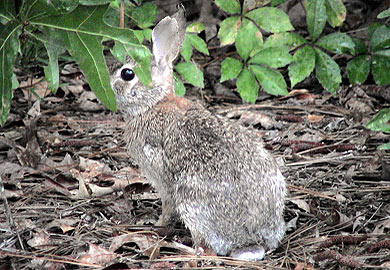DNR News
** Archived Article - please check for current information. **
March 20, 2014
Brushy ditch banks, weedy field borders are beneficial to wildlife around farms
Brushy ditch banks and weedy field borders may not be attractive to some people, but many of South Carolina's favored farm wildlife and game species depend on these areas for their very survival.
"Bobwhite quail and cottontail rabbits, as well as many songbirds, depend on areas dominated by grasses, weeds and small shrubs," said Willie Simmons, Small Game Project supervisor for the S.C. Department of Natural Resources (DNR). "These areas provide critical nesting and brood-rearing habitat necessary for these species to reproduce successfully and survive." For wildlife management technical assistance or for more information, contact the DNR Small Game Project in Columbia at (803) 734-3609.
To many landowners and farmers, managing for wildlife means planting of supplemental food plots. But according to Simmons, this effort is largely wasted without adequate nesting and brood-rearing areas to allow birds and animals to reproduce successfully. It is also a misconception among many landowners and farmers that wildlife management must be an intensive effort. "Some of the more beneficial practices, such as transition zones, filter strips, and hedgerows can be established by simply letting areas grow up in native vegetation," Simmons said. "It is a case of doing more for wildlife by doing less on the farm."
A transition zone, or field border, is a strip of native vegetation around the perimeter of a planted crop field. These areas should be at least 30 feet wide and should be allowed to grow up in native weeds, grasses and briars. Farmers know, and precision farming has demonstrated, that these areas tend to be among the less productive areas of the field due to shading and competition from adjacent woodlands. Field borders not only provide good nesting cover around crop fields, but also create a suitable environment for a wide variety of insects. Insects provide high protein food important to nesting hens, quail chicks and turkey poults during the nesting season.
These transition areas also grow many seed-producing plants, which provide food for adult birds during the winter months. A 30-foot strip, one-mile long, totals only about 3 acres. While the sacrifice of plantable acreage is small, the benefits to wildlife can be tremendous. Monitoring of the CP33 practice, Habitat Buffers for Upland Birds, indicates that field borders alone consistently double the numbers of quail on the farm. Field borders also improve water quality by trapping sediment and nutrients transported from crop fields by heavy rains.
"Management of the field borders is simply a matter of keeping these areas in an early stage of plant succession," Simmons said. "For example, let strips grow for two years when you are getting them established. Then every two years, lightly disc one-half of the field border and let it grow up again. In order to provide maximum benefits for quail and other wildlife, these areas should be protected from herbicide drift and should not be used as access roads, turn rows, or for storage of equipment."
Conservation tillage practices, such as no-till and strip-till farming, provides wildlife habitat benefits, as well as soil and water conservation benefits.
Hedgerows, brushy fence rows, and ditch banks provide needed escape cover and can serve to connect other areas of suitable habitat, such as field borders. Rather than mowing these areas annually, allow these areas to grow up in natural vegetation like honeysuckle, blackberries, sumac, wild cherry, grapevines, sassafras, greenbrier and wild plum. Very large fields will benefit from allowing hedgerows to develop, dividing large fields into smaller units.
"Land-use practices have changed dramatically in the past 60 years in South Carolina, and those changes have not been beneficial to many species of wildlife, especially traditional farm wildlife species like quail and rabbits," Simmons said. "By replicating the conditions that occurred many years ago in the farm landscape, populations of these popular game animals, and many other wildlife species, can be increased."
A number of programs are available through the U.S. Department of Agriculture to assist farmers with establishing soil, water and wildlife conservation practices. Practice CP33 (Habitat Buffers for Upland Birds) specifically addresses the need for field borders in agricultural cropping systems by providing landowners incentive payments and annual rental payments for the installation and maintenance of field borders. Contact your county Farm Service Agency or Natural Resources Conservation Service office for information on installing field borders, filter strips, field windbreaks and other conservation practices. Local DNR wildlife biologists and Soil and Water District Conservationists can assist landowners in planning and implementing a management plan for their property to address natural resource concerns, including wildlife habitat enhancement.
More News
- Spring turkey season forecast good, youth day March 29
- Brushy ditch banks, weedy field borders are beneficial to wildlife around farms
- March Madness is underway for weather observation
- Boardwalk at Dungannon Plantation Heritage Preserve closed to protect nesting wood storks
- Boating Infrastructure Grant Workshop on April 22 in Charleston
- Lifetime Fishing License awarded for participation in Lower Saluda Trout Study
- 4.1 magnitude earthquake rattles Edgefield on Feb. 14
- Spring turkey hunters should order tags now for upcoming season
- Adult-youth fishing open at Bonneau Ferry
- DNR hosts series of youth fishing rodeos/family fishing clinics around the state
- Antler measuring sessions set across South Carolina
- 2nd Annual SCDNR Youth Bass Fishing Championship to be held on Lake Murray March 29
- Freshwater fishing trends
- Saltwater fishing trends
- S.C. weekly tidetable
- DNR video
- Archived news releases
